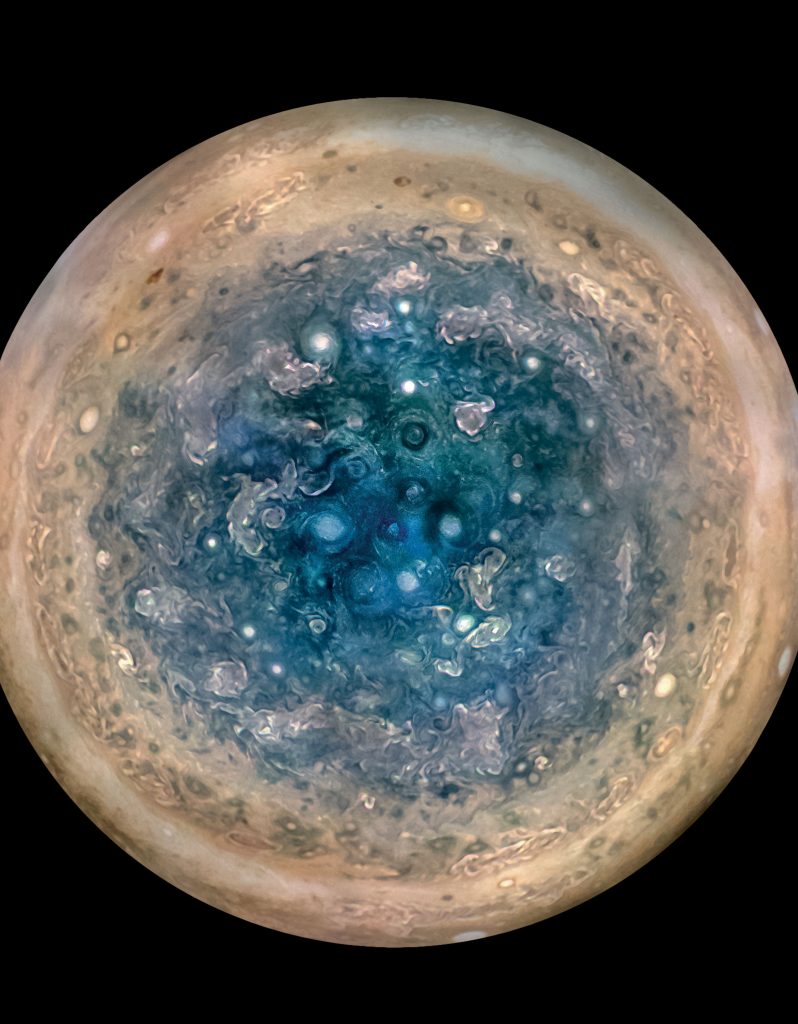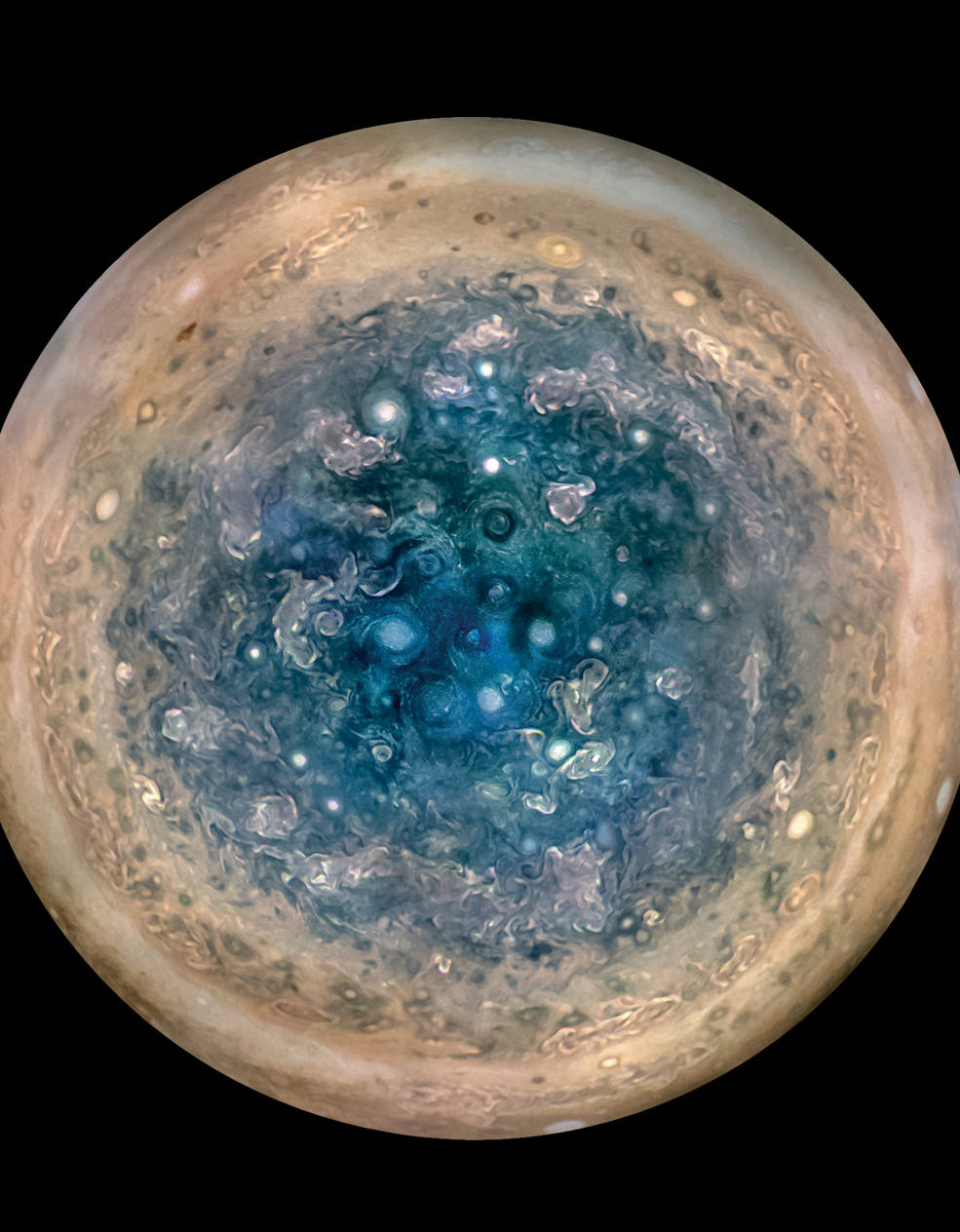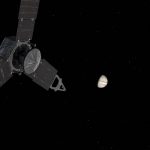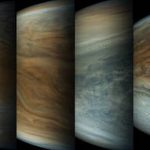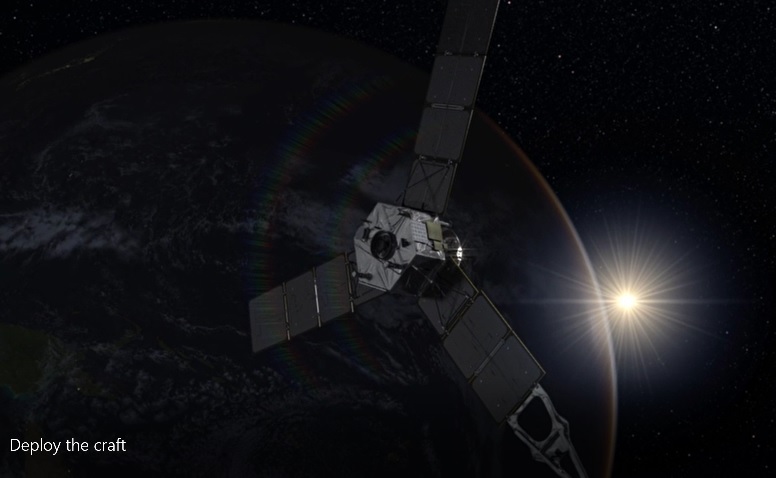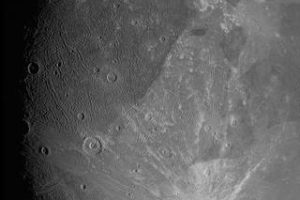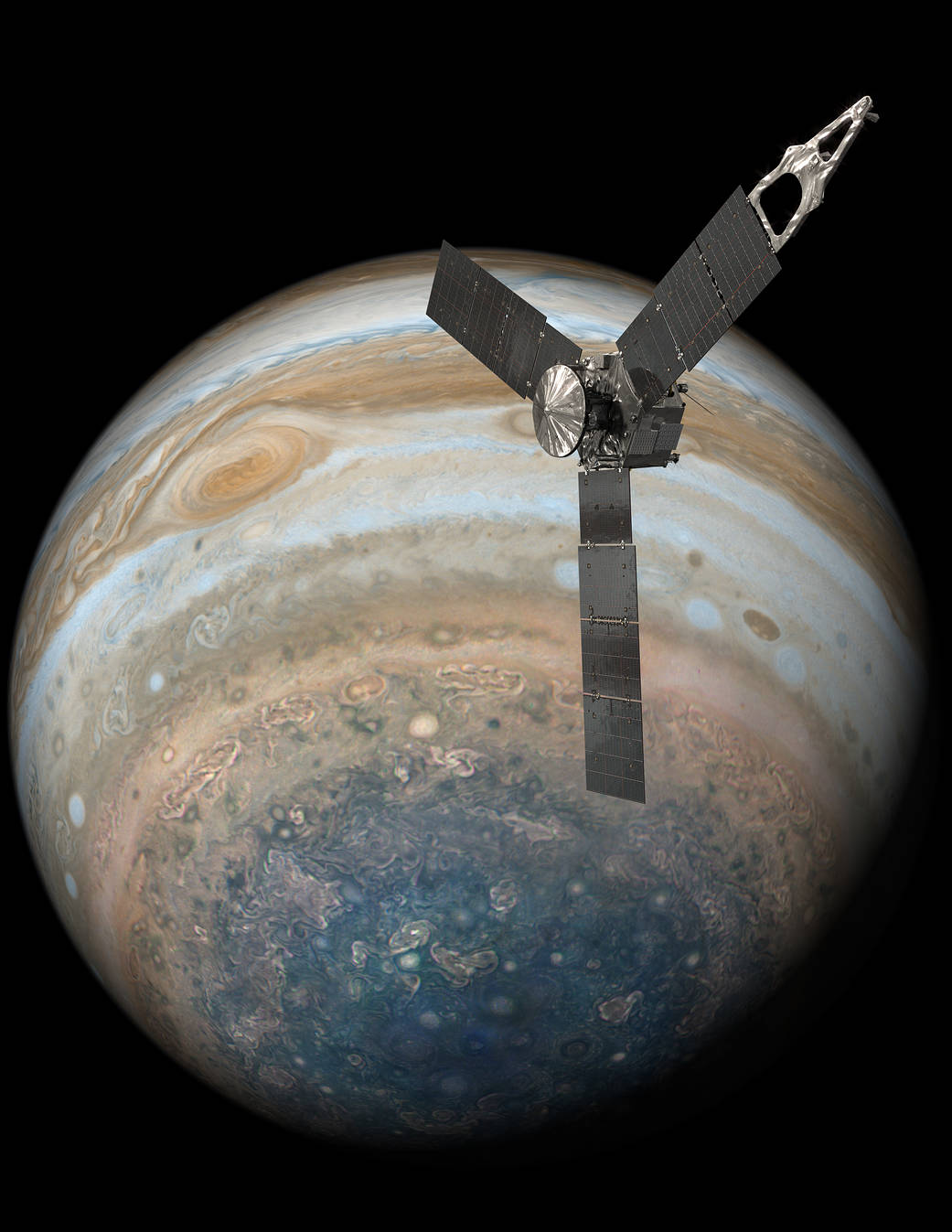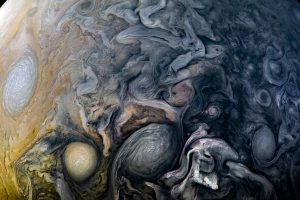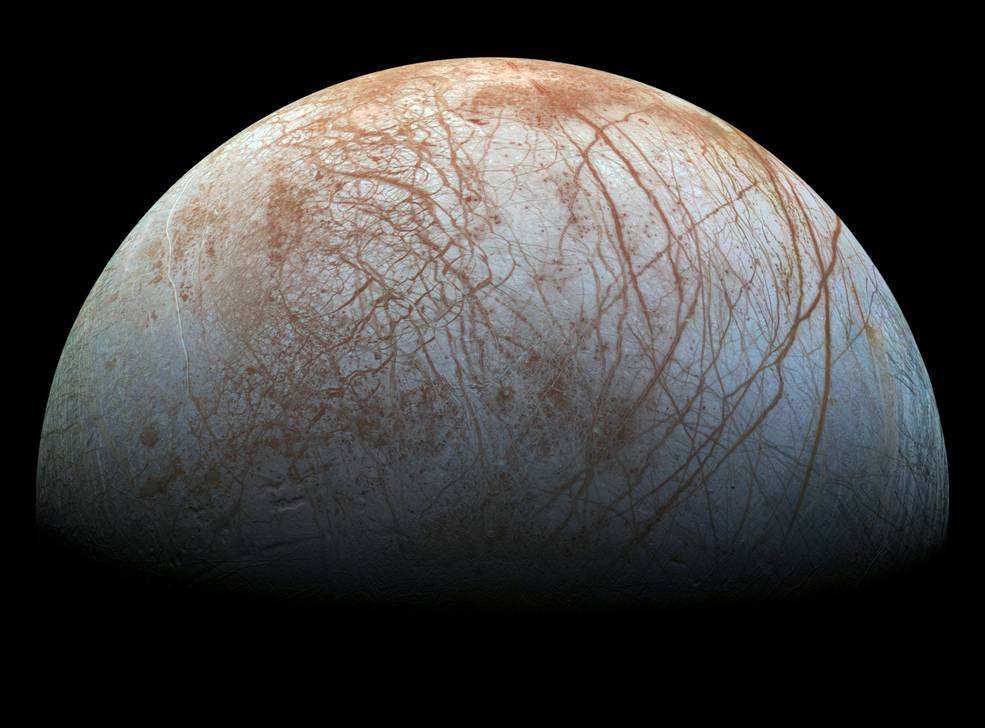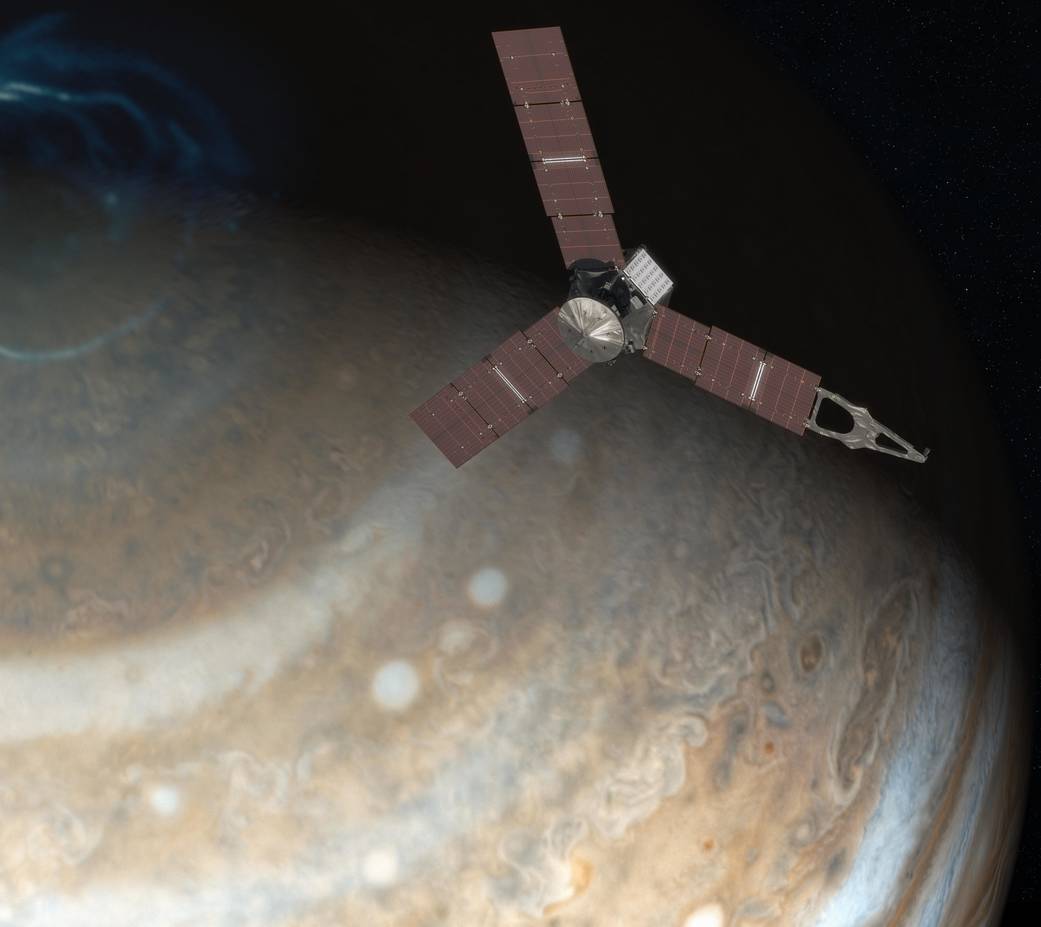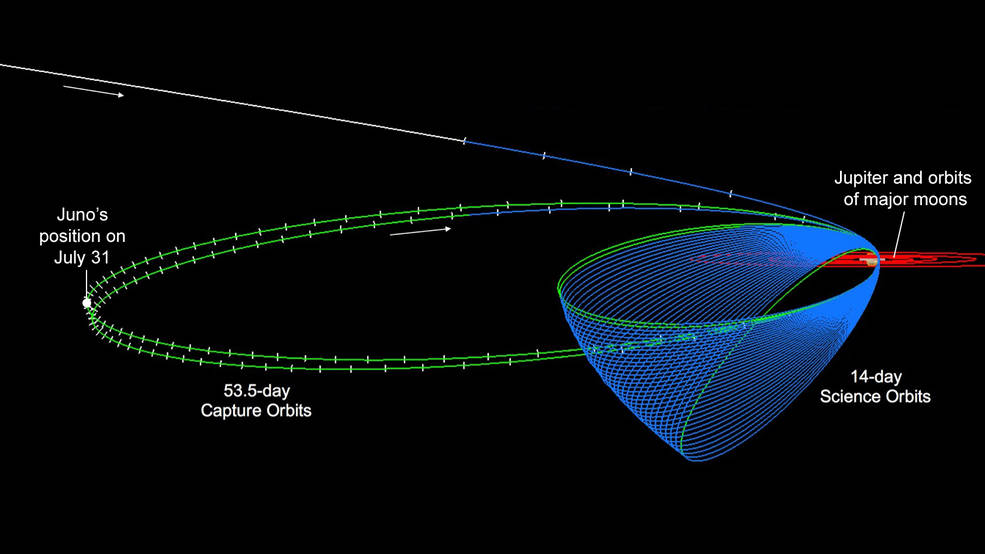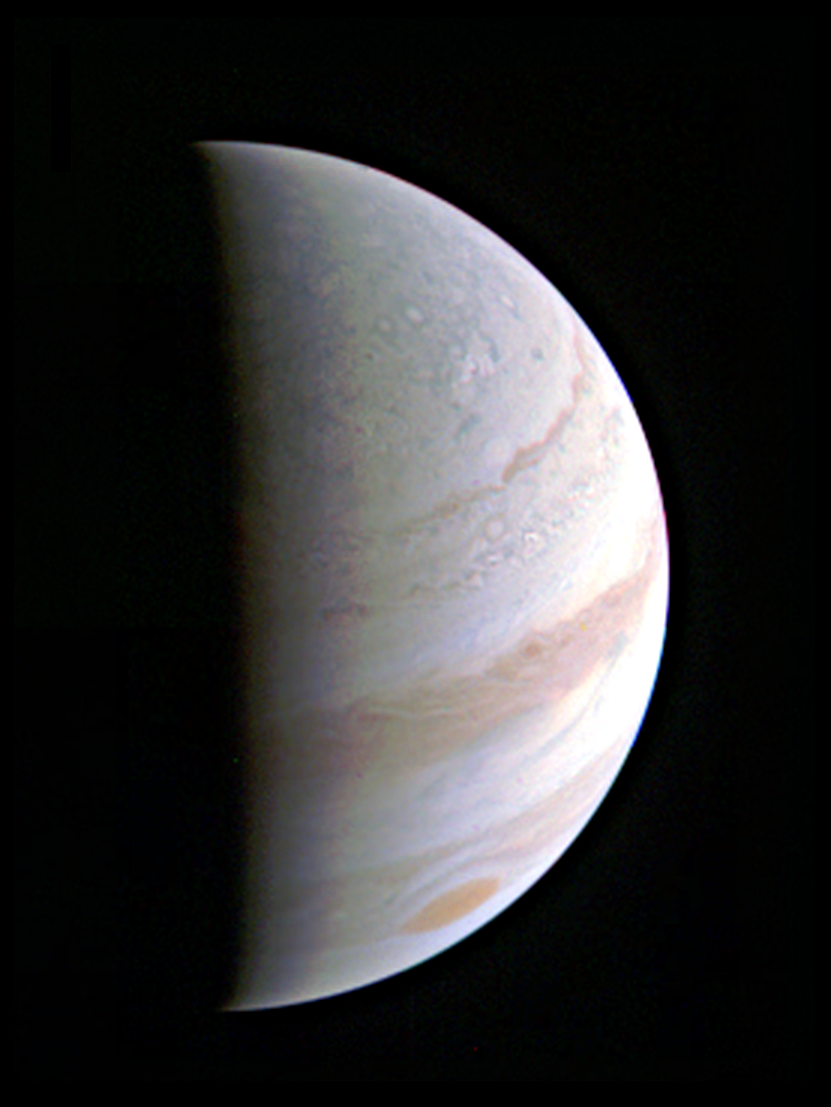This image shows Jupiter’s south pole, as seen by NASA’s Juno spacecraft from an altitude of 32,000 miles (52,000 kilometers). The oval features are cyclones, up to 600 miles (1,000 kilometers) in diameter. Multiple images taken with the JunoCam instrument on three separate orbits were combined to show all areas in daylight, enhanced color, and stereographic projection.
この画像はNASAの木星探査機ジュノーが32,000マイル(52,000キロメートル)の高度から見た木星の南極です。特徴的な直径最大600マイル(1,000キロメートル)の楕円形のものはサイクロンです。 ジュノーカムで3つの別々の軌道上から撮影した複数の画像から昼光、色彩補正、および立体投影の画像処理により全体像を表示しました。
Credits: NASA/JPL-Caltech/SwRI/MSSS/Betsy Asher Hall/Gervasio Robles
記事名
May 26, 2017
RELEASE 17-051
A Whole New Jupiter: First Science Results from NASA’s Juno Mission
オリジナル記事
Early science results from NASA’s Juno mission to Jupiter portray the largest planet in our solar system as a complex, gigantic, turbulent world, with Earth-sized polar cyclones, plunging storm systems that travel deep into the heart of the gas giant, and a mammoth, lumpy magnetic field that may indicate it was generated closer to the planet’s surface than previously thought.
“We are excited to share these early discoveries, which help us better understand what makes Jupiter so fascinating,” said Diane Brown, Juno program executive at NASA Headquarters in Washington. “It was a long trip to get to Jupiter, but these first results already demonstrate it was well worth the journey.”
Juno launched on Aug. 5, 2011, entering Jupiter’s orbit on July 4, 2016. The findings from the first data-collection pass, which flew within about 2,600 miles (4,200 kilometers) of Jupiter’s swirling cloud tops on Aug. 27, are being published this week in two papers in the journal Science, as well as 44 papers in Geophysical Research Letters.
“We knew, going in, that Jupiter would throw us some curves,” said Scott Bolton, Juno principal investigator from the Southwest Research Institute in San Antonio. “But now that we are here we are finding that Jupiter can throw the heat, as well as knuckleballs and sliders. There is so much going on here that we didn’t expect that we have had to take a step back and begin to rethink of this as a whole new Jupiter.”
Among the findings that challenge assumptions are those provided by Juno’s imager, JunoCam. The images show both of Jupiter’s poles are covered in Earth-sized swirling storms that are densely clustered and rubbing together.
“We’re puzzled as to how they could be formed, how stable the configuration is, and why Jupiter’s north pole doesn’t look like the south pole,” said Bolton. “We’re questioning whether this is a dynamic system, and are we seeing just one stage, and over the next year, we’re going to watch it disappear, or is this a stable configuration and these storms are circulating around one another?”
Another surprise comes from Juno’s Microwave Radiometer (MWR), which samples the thermal microwave radiation from Jupiter’s atmosphere, from the top of the ammonia clouds to deep within its atmosphere. The MWR data indicates that Jupiter’s iconic belts and zones are mysterious, with the belt near the equator penetrating all the way down, while the belts and zones at other latitudes seem to evolve to other structures. The data suggest the ammonia is quite variable and continues to increase as far down as we can see with MWR, which is a few hundred miles or kilometers.
Prior to the Juno mission, it was known that Jupiter had the most intense magnetic field in the solar system. Measurements of the massive planet’s magnetosphere, from Juno’s magnetometer investigation (MAG), indicate that Jupiter’s magnetic field is even stronger than models expected, and more irregular in shape. MAG data indicates the magnetic field greatly exceeded expectations at 7.766 Gauss, about 10 times stronger than the strongest magnetic field found on Earth.
“Juno is giving us a view of the magnetic field close to Jupiter that we’ve never had before,” said Jack Connerney, Juno deputy principal investigator and the lead for the mission’s magnetic field investigation at NASA’s Goddard Space Flight Center in Greenbelt, Maryland. “Already we see that the magnetic field looks lumpy: it is stronger in some places and weaker in others. This uneven distribution suggests that the field might be generated by dynamo action closer to the surface, above the layer of metallic hydrogen. Every flyby we execute gets us closer to determining where and how Jupiter’s dynamo works.”
Juno also is designed to study the polar magnetosphere and the origin of Jupiter’s powerful auroras—its northern and southern lights. These auroral emissions are caused by particles that pick up energy, slamming into atmospheric molecules. Juno’s initial observations indicate that the process seems to work differently at Jupiter than at Earth.
Juno is in a polar orbit around Jupiter, and the majority of each orbit is spent well away from the gas giant. But, once every 53 days, its trajectory approaches Jupiter from above its north pole, where it begins a two-hour transit (from pole to pole) flying north to south with its eight science instruments collecting data and its JunoCam public outreach camera snapping pictures. The download of six megabytes of data collected during the transit can take 1.5 days.
“Every 53 days, we go screaming by Jupiter, get doused by a fire hose of Jovian science, and there is always something new,” said Bolton. “On our next flyby on July 11, we will fly directly over one of the most iconic features in the entire solar system — one that every school kid knows — Jupiter’s Great Red Spot. If anybody is going to get to the bottom of what is going on below those mammoth swirling crimson cloud tops, it’s Juno and her cloud-piercing science instruments.”
NASA’s Jet Propulsion Laboratory in Pasadena, California, manages the Juno mission for NASA. The principal investigator is Scott Bolton of the Southwest Research Institute in San Antonio. The Juno mission is part of the New Frontiers Program managed by NASA’s Marshall Space Flight Center in Huntsville, Alabama, for the agency’s Science Mission Directorate. Lockheed Martin Space Systems, in Denver, built the spacecraft.
More information on the Juno mission is available at:
https://www.nasa.gov/juno
http://missionjuno.org
Follow the mission on Facebook and Twitter at:
http://www.facebook.com/NASAJuno
Tweets by NASAJuno
-end-
Dwayne Brown / Laurie Cantillo
Headquarters, Washington
202-358-1726 / 202-358-1077
dwayne.c.brown@nasa.gov / laura.l.cantillo@nasa.gov
DC Agle
Jet Propulsion Laboratory, Pasadena, Calif.
818-393-9011
agle@jpl.nasa.gov
Nancy Neal Jones
Goddard Space Flight Center, Greenbelt, Md.
301-286-0039
nancy.n.jones@nasa.gov
Deb Schmid
Southwest Research Institute, San Antonio
210-522-2254
dschmid@swri.org
Last Updated: May 26, 2017
Editor: Karen Northon
日本語訳
私たちの太陽系における最大の惑星である木星に対するNASAのジュノーミッションの最初の科学的な成果は、地球と同じ大きさにもなる巨大なサイクロンである複雑な乱気流や、塊のような地場が、以前考えられていたようにガスの巨大惑星の中心部まで深く流れているのではなく、比較的木星の表面の近くで生成されたことを示すものでした。
「これらの早期発見から、木星がなぜこうも魅力的なのかを知ることになり、大変興奮しています。」と、ワシントンのNASA本部のジュノープログラム担当ディレクター、ダイアン・ブラウンは述べています。「木星にたどり着くまでは長い旅でしたが、これらの最初の結果はすでにその旅の価値あるものであったことを示しています。」
ジュノーは2011年8月5日に打ち上げられ、2016年7月4日に木星の軌道に入りました。8月27日に木星の渦巻く雲の上約2,600マイル(4,200キロメートル)を飛行し、最初のデータ収集をしました。その観測結果を、今週の「journal Science」誌の2つの論文と「Geophysical Research Letters」の44の論文に掲載されています。
「当初。木星は私たちにカーブを投げてきていました。しかし、今は私たちに木星がナックルボールとスライダーだけでなく直球も投げてきています。今や予想もしていなかったことが起きているので、私たちはホームベースから一歩立ち位置を下げて、新しい木星を一から考え直さねばならないのです。」と、サンアントニオのサウスウエスト研究所の主任研究員であるスコット・ボルトンがいっています。
大胆な仮説がジュノーに搭載したカメラであるジュノーカムで撮影した画像から得られています。画像から、木星の北極と南極が、地球と同じくらいの大きさにもなる渦巻き状の嵐で覆われていることを示しているのです。
「木星の北極と南極が、どうやってこうなったのか、どうしてこの状態を状態を維持しているのか、どうして北極と南極の外見が異なっているのか、頭を悩ませています。」 と、ボルトンは語り、「この状態は変化してゆくのか疑問を持っています。何故なら我々はまだ1つの段階しか見ていません。翌年には、それが消えていくかもしれませんし、これらの嵐は互いに周りを回って安定しているかもしれません。」
ジュノーミッションの開始前から、木星が太陽系内で最も強い磁場を持つことが知られていました。 ジュノーに搭載している磁力測定装置(MAG)で巨大惑星の磁気圏の測定した結果、木星の磁場が予想したよりもさらに強く、より不規則であることがわかりました。 MAGデータでは磁場が7.766ガウスで、予想を大幅に上回っていることを示しています。これは地球での最も強い磁場よりも約10倍強力なものです。
「ジュノーは史上初となる木星接近により、磁場の情報をもたらしてくれました。」と、メリーランド州グリーンベルトのNASAのゴダード宇宙飛行センターのミッションの磁場調査の主任であるジャック・コネリーは言いました。「磁場が塊状に見えることは既にわかっています。ある場所では磁場が強く、他の場所では弱いといった具合です。この不均一な分布は、金属水素の層の上の表面に近い場所での発電作用によって場が生成されることを示唆しています。ジュノーが行う全ての飛行は、木星の発電作用がどこでどのように起きているかを解明してゆくことになります。
ジュノーはまた、北極と南極に現れる木星の強力なオーロラの起源ともなっている北極と南極の磁場を調査するように設計されています。このオーロラは、エネルギー粒子が大気分子に衝突して放出されるエネルギーによって引き起こされます。 ジュノーの最初の観測により、このプロセスが地球と木星では異なっていることを示しています。
ジュノーは木星の極を周回する軌道にあり、軌道上のほとんどはガス巨大惑星である木星から十分に離れています。しかし、53日に一度、その軌道は北極の上から木星に近づき、南極を通過するまでの2時間にわたり、8つの科学観測装置がデータを収集しジュノーカムで撮影した画像と共に地球へ転送を始めます。6メガバイトのデータの転送には1.5日かかります。
訳者注
いよいよ次回より、木星観測の詳細について本サイトでレポートしていきます!
乞うご期待です。
なお、今回の木星の南極のオリジナル画像は以下になります。画像クリックで拡大表示(2646 × 3395)します。
